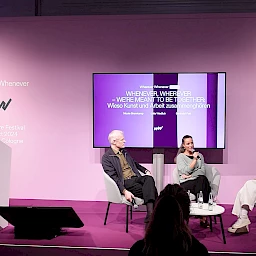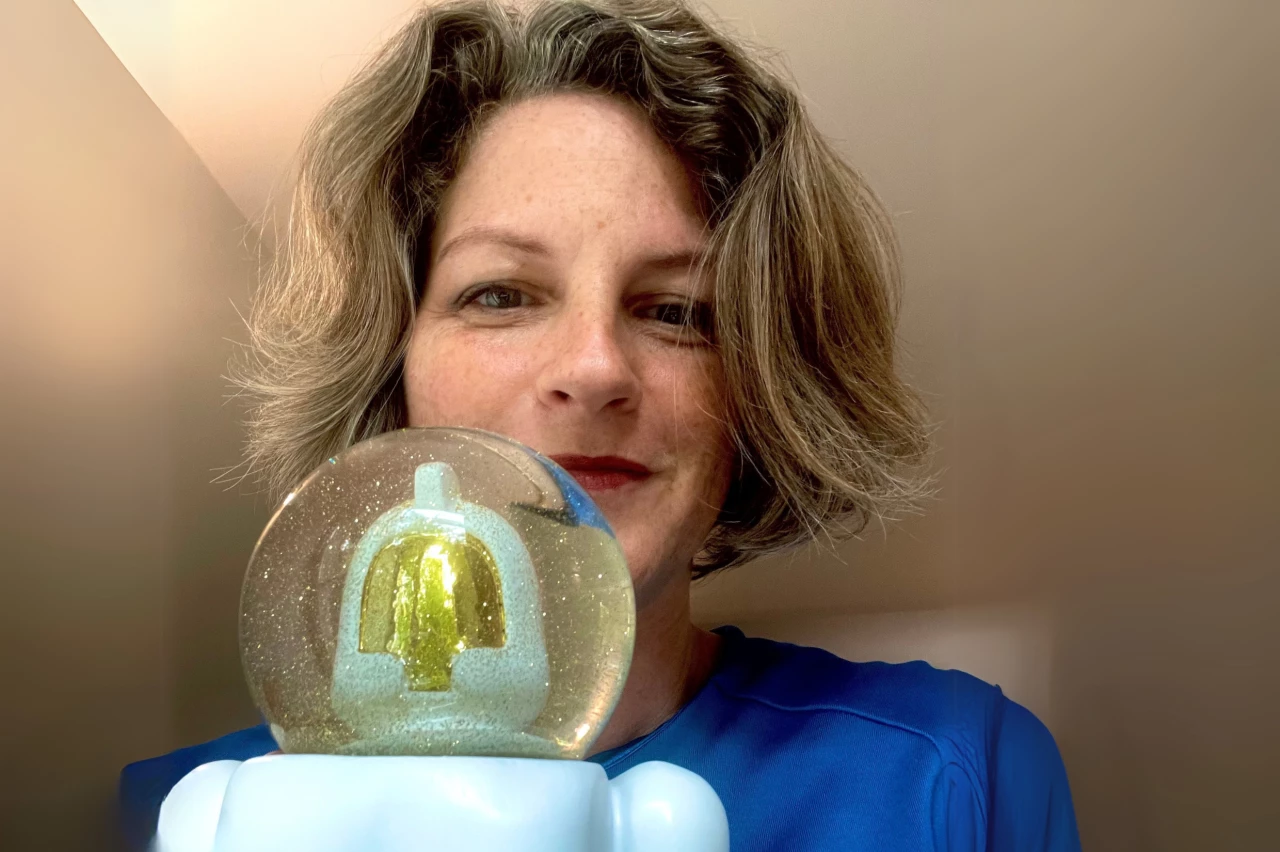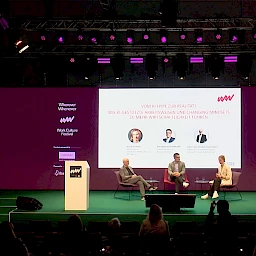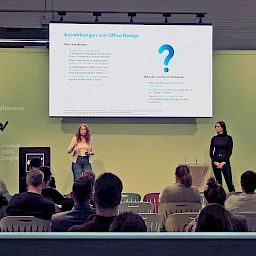Artificial intelligence is increasingly changing the processes and structures of knowledge work. In her recent “New Work Order” study, trend researcher Birgit Gebhardt analyses the effects of these developments on forms of collaboration, work organisation and the design of office and learning environments. In this interview, she provides insights into her research approach, key questions and initial results.
You’ve been researching the future of work for many years. Why is now the right time to investigate the impact of AI on collaboration?
Because artificial intelligence is now changing office processes. For example, AI can be used to usefully network or automate business processes (e.g. IBM, SAP) in the cloud. We’re now also experiencing how numerous office tool applications (e.g. Microsoft) are communicating with us, documenting knowledge and, in a sense, joining us in thinking about content. This performance boost will bring a new dynamic to the networked group, and I would like to know how this efficiency can be tangibly experienced in our collaboration.
What makes your study different from other AI studies?
My focus isn’t on the performance boost from AI, which is obvious. I’m interested in how a company’s performance will develop once AI itself has become more or less standard and humans once again make the difference. Who will then work together how and where to generate performance, innovation and competitive advantage? I’m catapulting myself into the future, so to speak, and asking how collaboration will work when AI has transformed our business processes and AI agents take over entire work processes for us, both professionally and privately: how do we then interact with AI — and with each other?
What insights or perspectives can readers expect?
I’m interested in the further development of knowledge work in the organisation — pushed forward by the inclusion of AI. One aim is to find out how the advent of AI is changing human knowledge work in departments, workflows and the value chain. Where is human intervention still essential, and how is collaboration changing there? How else will we generate and share knowledge in the future? Another research focus is on user-centricity. As a trend researcher, I always ask about the benefits for the end customer or user, and with AI, this results from simplified access to knowledge, solutions, translations and display formats. I am interested in how our user experience changes through collaboration with AI — for the iterative steps with the AI and the interactive ones with each other: what new working realities, simulations and interaction formats are changing collaboration? And which of the necessary requirements could point offices in a new direction?
In the first part of the study, you outline development potential for knowledge work.
Where do you see the most exciting fields of application for AI in knowledge work and learning?
On the one hand, there is the assistive support and adaptive knowledge transfer for almost all issues. Thanks to a quasi-natural dialogue capability, knowledge acquisition and knowledge application can take place situationally and spontaneously, and can be tracked, commented on, shared and adjusted in real time via monitoring with the user’s own interaction. AI’s immediate feedback can transform actions into conscious experiences and thus boost individual learning success. This also applies to learning experiences in a team.
How is communication in offices changing?
It is quicker and easier because the translation steps to working formats or software applications are no longer necessary. Tasks can also be delegated to agents who follow several work orders and process steps independently. The fact that AI is increasingly likely to interpret us and our work tasks correctly means that we can communicate more freely, directly and content-driven.
And how is AI changing the way teams work together?
Here too, LLMs and visualisation tools can facilitate understanding between members of highly mixed teams. The fact that we can talk to AI almost like a human makes it seem like a fully-fledged team member who is more knowledgeable and is therefore ever increasingly included. Above all, however, AI provides the necessary information from research, back office or customer journeys on an ad hoc basis and can enrich the solution process with valid data and risk-minimising simulations. Teams are increasingly initiating, supporting and reviewing the work results of AI by defining the parameters, strategies and goals, aligning company interests with customer benefits and once again giving their desire for research and creative aptitude more space. The concept of agile teams that can collaborate across disciplines even more easily with AI in order to come up with new ideas and solutions remains important. A good mix of expertise and customer perspective would be important in order to be able to benefit from the team’s wealth of experience and our own feeling for change.
Your study analyses human-AI interactions. Which new working patterns break particularly drastically with traditional team structures?
The better AI gets at networking entire solution steps in a meaningful way, the more we are inclined to let it do the work for the time being. While AI is learning, we run the risk of forgetting knowledge and monitoring the solution process less intensively. Professor Dieter Kranzlmüller, who heads the Leibniz Supercomputing Centre in Munich-Garching, reports that the supercomputers are already negotiating autonomously with the quantum computer as to which computer will take on which task for the scientists. And the more process steps the AI distributes and processes internally, the more the human work will be divided between the beginning of posing the question and the review of the result at the end. Kranzlmüller sees the review of questionable AI results as one of the main tasks of future specialists, who must be able to trace the path back from the AI result and be equipped with a correspondingly high skill set for assessing the content and correcting the AI. In addition, the speed of the output will increase the group dynamic, but can also become a disadvantage for teamwork. This is the case when the team is fooled by the AI presentation because the result formats appear to be so perfect — as if they had been completely thought through. It’s also the case if only one person doubts the AI result but doesn’t dare to swim alone against the tide, for example because the tight schedule hardly allows for critical questioning or the relevant expertise to solve the problem is not available anyway. Anyone who views their job as a matter of getting something done will find AI to be very supportive. But this result alone is no longer how we should understand our work in future.
You also address new criteria for the working environment in the study. What do spaces that promote this new form of collaboration look like?
This depends on the work’s intention and the atmosphere that is conducive to it. Even before AI was taken into account, it was clear that the functional roles that the workspace should support also include emotional triggers that address the participants’ interest in each other. Now that teams are constantly interrupting their thought processes to enrich them with AI, it’s important to enhance the multisensory effects even further. The office, in particular, should see it as its task to couple sensory impressions with cognitive experiences in order to make the experience of learning and the cohesion of the collaboration tangible. Today, physical offices are competing against digital glasses, video games and metaverses that create immediate application environments and enable virtual teamwork. However, because it’s rarely possible to bring all team players together on site at the same time in the physical office environment, the office should further expand multisensory integration for hybrid formats. This means that people connected remotely must be put on an equal footing with the participants on site, both situationally and formally, or they should be able to orient themselves and navigate between those present in order to feel like an active participant. I think that here, too, AI-supported sensors and technical interfaces will enable more intensive interaction, which would then also have to be made more seamless in terms of spatial perception.
Please also read

Which methodology do you use?
I look at what is happening outside the office environment, how knowledge work is changing in general and which technological innovations offer economic and application-oriented advantages. Because I have been researching and advising on the future of networked work culture for twelve years now, I quickly notice new patterns and also like to look for clues in other bubbles. The work of the study then forces me to question, condense, substantiate and think about parallel trends in a networked way. I sharpen my hypotheses through my consulting clients, travel, visits, conferences, committee work, research and the evaluation of scientific studies. To describe the change, I interview selected experts and scientists from AI and software development, process automation, game development, neuroscience, UX and learning pedagogy, the creative scene, architecture and spatial planning, behavioural research and colleagues from special segments of management consulting. As a pioneer case or for a reality check, I address startups that develop AI for business processes or companies that strategically integrate AI into all their processes. The lessons learned by these pioneering companies may also serve as recommendations for action.
Birgit, thank you for talking with us.






